How to Increase Hard Drive Speed on Windows 10 [Step-by-Step Guide]
Have you ever faced the slow booting speed of your PC? If yes, then it's only because of the slowness of the hard drive speed. No wonder this might be mainly because of low disk space and an old hard drive, but what's the solution? How to increase hard drive speed on Windows 10?
No need to worry anymore; you can quickly fix it! The wait is finally over! We are here to present you with some of the most effective ways to resolve this issue via this post. So, let's get into the details without wasting any more time.
Why My Hard Drive Gets Slower
It's a fact that the performance of the hard drives will degrade as they age, but the question is, what are the prime causes of this performance slowdown? Here are a few causes that can affect the hard drive. The reasons are like
- Temporary files
- Low disk space
- Bad sector on the hard drive
- Multiple background application
- Physical issues with mechanical parts
These are some of the prime factors which slow down the hard drive and annoy Windows users to boot their PC slowly. You can run an HDD benchmark test to get precise data on the hard drive speed. And next, we will continue to give ten ways to increase hard drive speed.
Ten Ways to Increase Hard Drive Speed on Windows 10
Here we will provide the ten most effective ways to increase the hard drive speed on Windows 10. So, follow the detailed guide and steps below to achieve the best speed for your hard drive.
Way 1. Partition Disk
Disk Partition, or dividing your hard drive storage into multiple parts, will always be helpful for the PC to access data quickly. Typically data stored in these partitions are always more well-organized than keeping everything in a single colossal drive. Qiling Disk Master is one of the leading software available in the market. This tool has loads of advanced features and a user-friendly interface.
Key Features of Qiling Disk Master
Apart from disk partition, the software also offers a tool for testing hard drive speed. It's called DiskMark and can be downloaded from the discovery section. Here is the list of features:
- Extend/shrink partitions
- Split/merge partitions on SSD/USB
- Move unallocated space to the C drive
- 1-Click-tool to test SSD read/write speed
- Speed up hard drive via extending partition or disk partitioning
In the next part, you can see how Qiling Disk Master helps extend partitions.
Way 2. Extend Partition to Get More Space
Low disk space is another big reason your hard drive performs slowly, and you can easily enhance the speed of your hard drive by extending the partition of your hard drive. Qiling Disk Master's exclusive and extensive partition functionality helps users extend the partition and provide more space to the PC. Follow the below steps:
Step 1. Locate the Target Partition.
Go to Partition Manager, locate the target partition and select "Resize/Move".
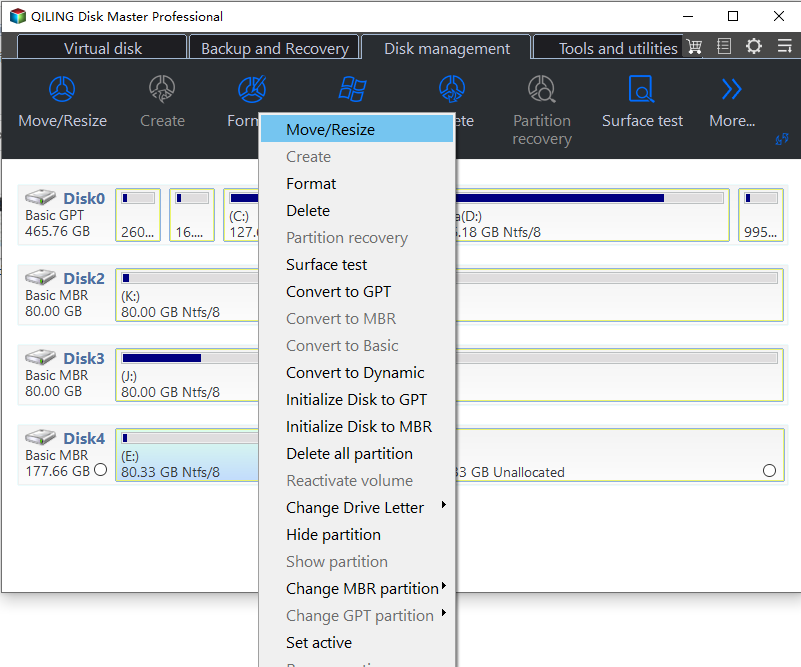
Step 2. Extend the Target Partition.
Drag the partition panel rightward or leftward to add the unallocated space into your current partition.
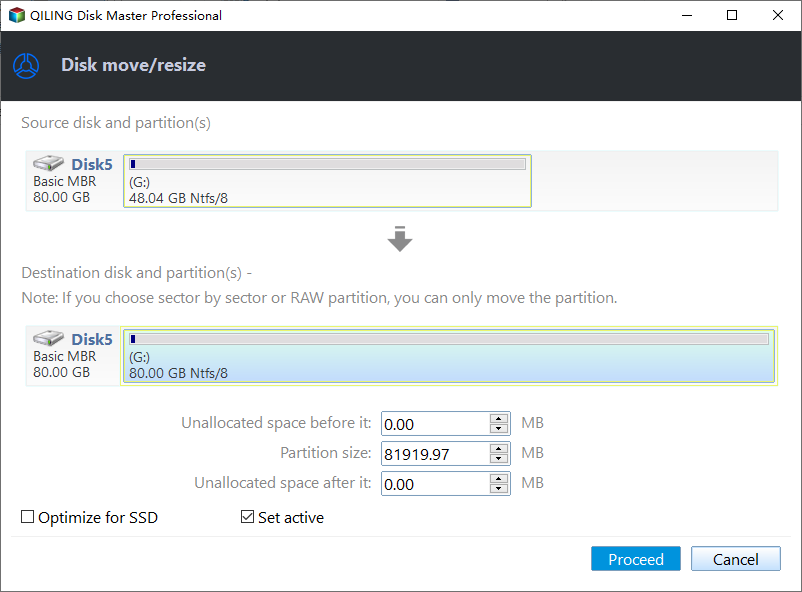
Extra Option: Get Space from Another Drive
If there is not enough unallocated space on your disk, right-click on a big partition with enough free space, select "Resize/Move".
Then select the target partition that you want to extend at the allocate space to column.

Step 3. Execute Operations to Extend Partition.
Drag the dots of the target partition into the unallocated space.

Then Click the "Proceed" button to keep all the changes.
Way 3. Enable Write Caching
You can increase the hard drive speed using Windows's enable write caching feature. This feature usually allows the physical memory and RAM to collect write command, which is then sent to the storage device like a hard drive. Enabling the write caching feature can cause data loss or corruption, so we suggest you take a data backup before enabling this feature. Now follow the steps below to perform this process.
Step 1. Left-click the Windows button, search for Device Manager, and press enter.
Step 2. Expand the Disk drives section on the Device Manager window. Now double-click on the drive that wants to enable the write caching.
Step 3. Go to the Policies tab, check Enable write caching on the device, and click OK.

Perform the same steps on all the storage devices your PC is associated with and see the result.
Way 4. Optimise Drives
Drives optimization can be another effective way to increase the hard drive speed on Windows 10. Follow the steps given below to perform the drive optimization process successfully.
Step 1. Right-click the Windows main menu button and select the Run option from the list.
Step 2. On the Run window, type cmd and press the enter button to open the Command Prompt.
Step 3. Once the Command Prompt window opens, type dfrgui and press Enter. It will open the Optimize Drives window.
Step 4. Select the drive you want to optimize and click the Optimize option.
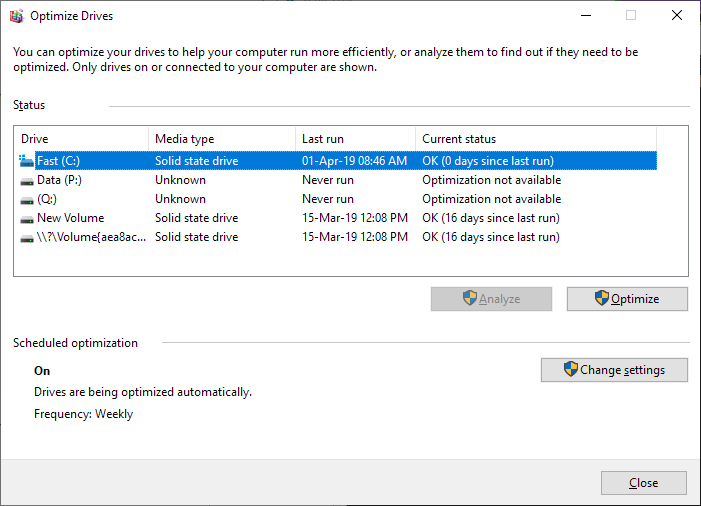
Way 5. Run CHKDSK Command
If your hard drive is performing poorly, then the chkdsk:/f/r command can help you find out the hard drive's bad sectors. It also allows you to recover those bad sectors; as a result, you can improve the speed of your hard drive. Follow the below steps to run the chkdsk command properly.
Step 1. Right-click the Windows main menu and select Run from the list.
Step 2. Now, on the Run window, type cmd and run Command Prompt as Administrator.
Step 3. Now, type chkdsk [Drive Name]: /f /r /x and hit Enter. The picture sets drive E as an example.
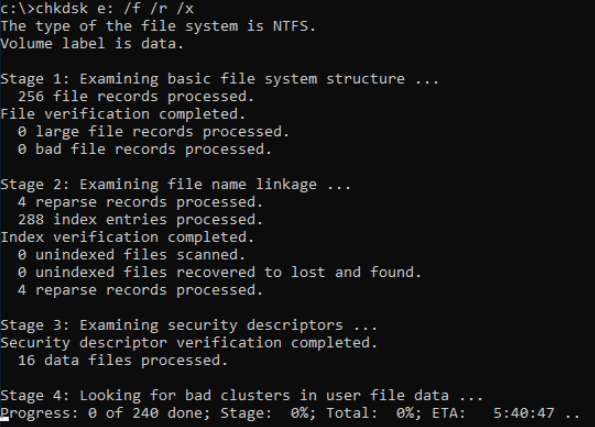
Here the /f stands for fixing any errors found on disk, and /r stands for locating bad sectors and recovering data from them.
Way 6. Remove Unwanted Files and Application
Removing unwanted files and applications can significantly increase the hard drive speed. If you want your hard drive to perform better, we recommend you perform a proper system check and delete all duplicate files and unnecessary applications. Follow the given steps to uninstall an unused application.
Step 1. Click the Windows key and search for the control panel. Now on the Control Panel window, click on the Programs option.
Step 2. Click on the Uninstall a program option under the Programs and Features section.
Step 3. Now select the application you want to remove from the list, right-click on it and click on the uninstall option.
Way 7. Run Disk Cleanup
The Windows Disk Cleanup feature boosts your hard drive's performance. Dick Cleanup usually scans your PC's storage device and removes all temporary files; as a result, you can experience performance enhancement of your HDD. Follow these steps to run Disk Cleanup.
Step 1. Right-click the Windows main menu and select Run from the list.
Step 2. Type cleanmgr and press Enter.
Step 3. Select the drive you want for Cleanup and click OK.
Step 4. Under Files to delete, select the files you want to delete and click on OK.
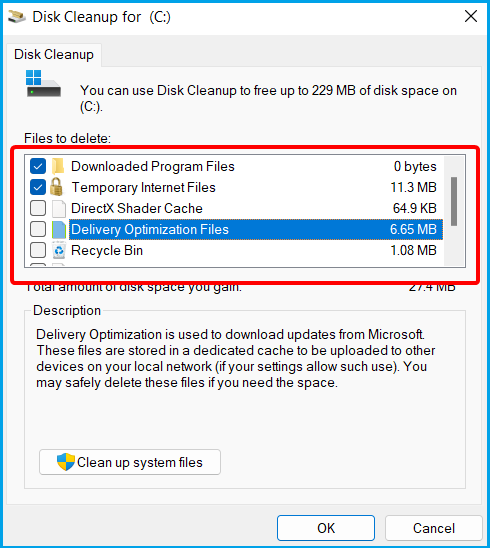
Step 5. Wait for the complete process of Deletion of files.
Way 8. Disable Virtual Memory/Paging File
Disabling the virtual memory/Paging file can improve the hard drive performance if your hard drive is slow and on low disk space. Follow the given steps to disable the virtual memory/ paging files.
Step 1. Left-click the Windows main menu and search for Settings options.
Step 2. Go to System > About > Advanced system settings from the left side panel.
Step 3. Click on the Advanced tab, and under the performance section, click on Settings.
Step 4. Again, click on the Advanced tab, and under Virtual Memory, click on the Change option.
Step 5. From the new window, disable the Automatically manage paging file size for all drives; now click on the No paging file option and click OK.
Step 6. Select Apply, then press the OK button.
Way 9. Delete Temporary Files
Deleting temporary files from your PC can improve your hard drive speed remarkably. We recommend you delete temporary files frequently to enhance your HDD performance. Please follow the steps below to delete temporary Windows files.
Step 1. Right-click the Windows button and select "Run" from the list.
Step 2. On the Run window, type "temp" and press Enter to navigate to the temporary files location.
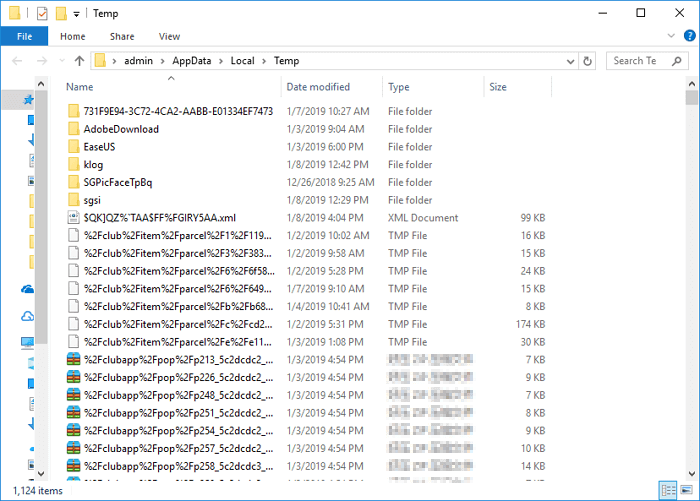
Step 3. Press Ctrl + A to select all the temporary files and press Shift + Delete to delete those files permanently.
Step 4. If it can't delete any files they are currently in use; in such case, skip those files.
Step 5. Again, open the Run window by following the previously mentioned steps, type %temp%, and press Enter.
Step 6. Delete all the files inside it permanently.
Way 10. Upgrade to SSD
We will recommend you upgrade to SSD (Solid State Drive). If you have installed your Operating system on your hard drive, your PC bootup time will be longer. If you want to increase your disk's speed, use an SSD on your PC. Any SSD's read and write speed is around 500 to 600 Mbps higher than a hard drive.
Conclusion
In this post, we have provided the ten most effective ways to speed up your hard drive on Windows 10. Try all of them to understand which one works best for you. For any queries, feels free to ask us in the comment section.
By the way, you may also like:
Increase Hard Drive Speed on Windows 10 FAQs
Here we have given some of the frequently asked questions answers which might clear your doubts, so read them thoroughly.
1. How Do I fix a slow hard drive in Windows 10?
You can fix a slow hard drive by uninstalling unwanted programs, upgrading the hard drive to a larger one, switching the SATA cable port, and cleaning up junk files from your hard drive.
2. Why is my HDD very slow?
If your HDD or hard disk drive is very slow, it can be because of several reasons like hardware failure, damaged disk, logic errors or bad sectors, or Insufficient power to the HDD portal.
3. How do I make my hard drive run like SSD?
If you want to make your hard drive run like SSD, then you must follow the below-given methods like the following:
- Delete temporary files
- Enable write caching
- Drive optimization
- Disable virtual paging files
Related Articles
- How to Solve OneDrive Sync Pending Error in Every Possible Way
- Repairing Disk Errors This Might Take an Hour - How to Fix?
- How to Fix Windows 10 DVD Drives Not Working? [2024 Guide]
- How to Mount a Disk on Mac [Step-by-Step Tutorial in 2024]